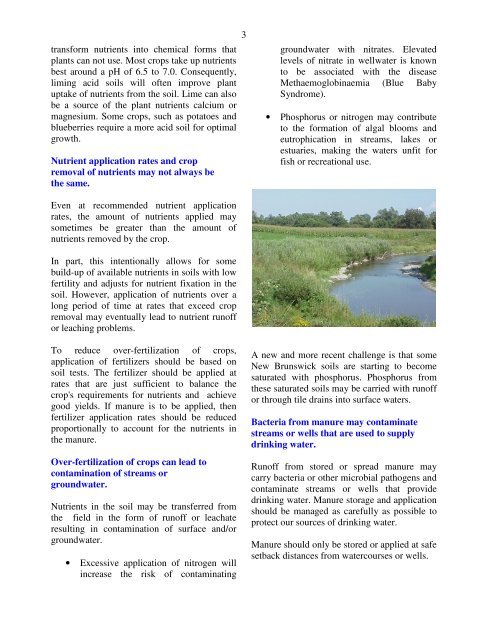Create successful ePaper yourself
Turn your PDF publications into a flip-book with our unique Google optimized e-Paper software.
transform nutrients into chemical forms that<br />
plants can not use. Most crops take up nutrients<br />
best around a pH of 6.5 to 7.0. Consequently,<br />
liming acid soils will often improve plant<br />
uptake of nutrients from the soil. Lime can also<br />
be a source of the plant nutrients calcium or<br />
magnesium. Some crops, such as potatoes and<br />
blueberries require a more acid soil for optimal<br />
growth.<br />
<strong>Nutrient</strong> application rates and crop<br />
removal of nutrients may not always be<br />
the same.<br />
3<br />
groundwater with nitrates. Elevated<br />
levels of nitrate in wellwater is known<br />
to be associated with the disease<br />
Methaemoglobinaemia (Blue Baby<br />
Syndrome).<br />
• Phosphorus or nitrogen may contribute<br />
to the formation of algal blooms and<br />
eutrophication in streams, lakes or<br />
estuaries, making the waters unfit for<br />
fish or recreational use.<br />
Even at recommended nutrient application<br />
rates, the amount of nutrients applied may<br />
sometimes be greater than the amount of<br />
nutrients removed by the crop.<br />
In part, this intentionally allows for some<br />
build-up of available nutrients in soils with low<br />
fertility and adjusts for nutrient fixation in the<br />
soil. However, application of nutrients over a<br />
long period of time at rates that exceed crop<br />
removal may eventually lead to nutrient runoff<br />
or leaching problems.<br />
To reduce over-fertilization of crops,<br />
application of fertilizers should be based on<br />
soil tests. The fertilizer should be applied at<br />
rates that are just sufficient to balance the<br />
crop's requirements for nutrients and achieve<br />
good yields. If manure is to be applied, then<br />
fertilizer application rates should be reduced<br />
proportionally to account for the nutrients in<br />
the manure.<br />
Over-fertilization of crops can lead to<br />
contamination of streams or<br />
groundwater.<br />
<strong>Nutrient</strong>s in the soil may be transferred from<br />
the field in the form of runoff or leachate<br />
resulting in contamination of surface and/or<br />
groundwater.<br />
• Excessive application of nitrogen will<br />
increase the risk of contaminating<br />
A new and more recent challenge is that some<br />
New Brunswick soils are starting to become<br />
saturated with phosphorus. Phosphorus from<br />
these saturated soils may be carried with runoff<br />
or through tile drains into surface waters.<br />
Bacteria from manure may contaminate<br />
streams or wells that are used to supply<br />
drinking water.<br />
Runoff from stored or spread manure may<br />
carry bacteria or other microbial pathogens and<br />
contaminate streams or wells that provide<br />
drinking water. Manure storage and application<br />
should be managed as carefully as possible to<br />
protect our sources of drinking water.<br />
Manure should only be stored or applied at safe<br />
setback distances from watercourses or wells.
















